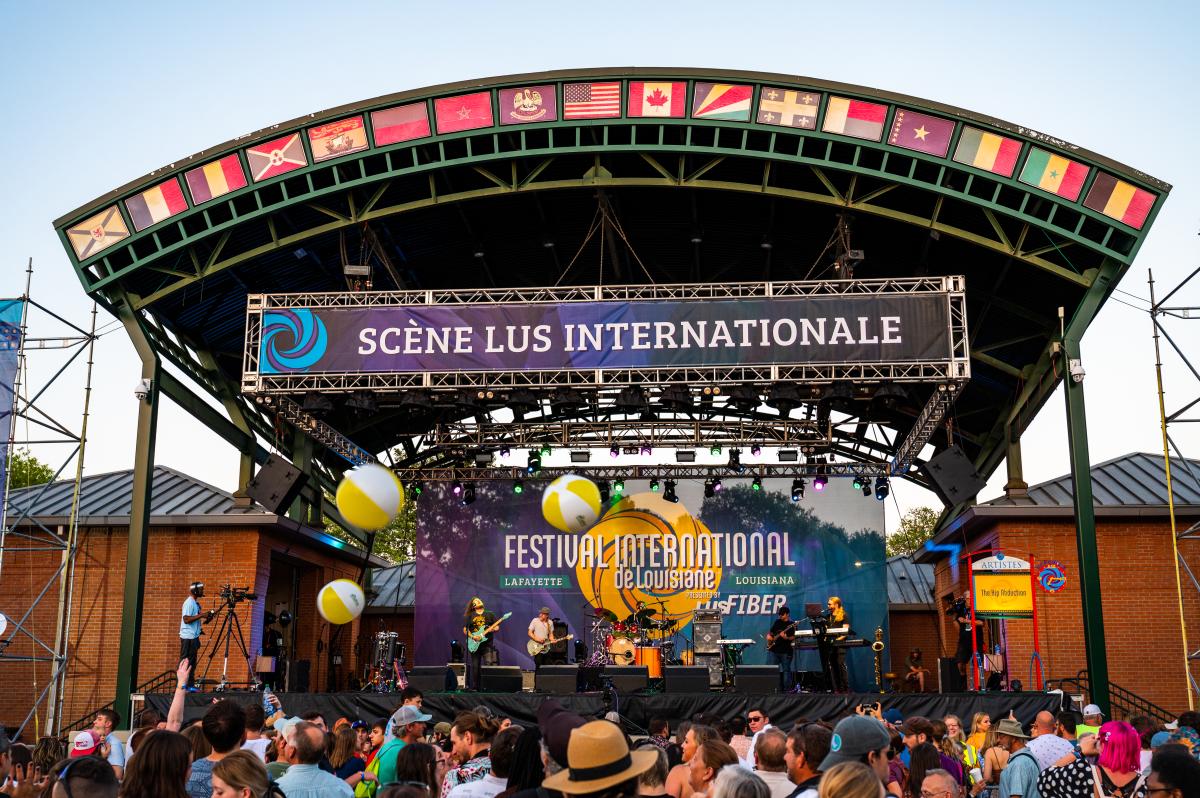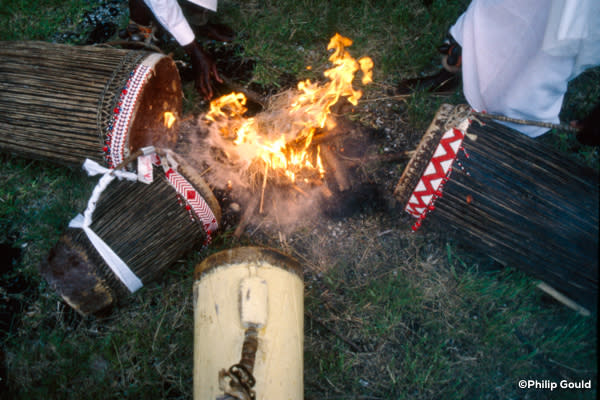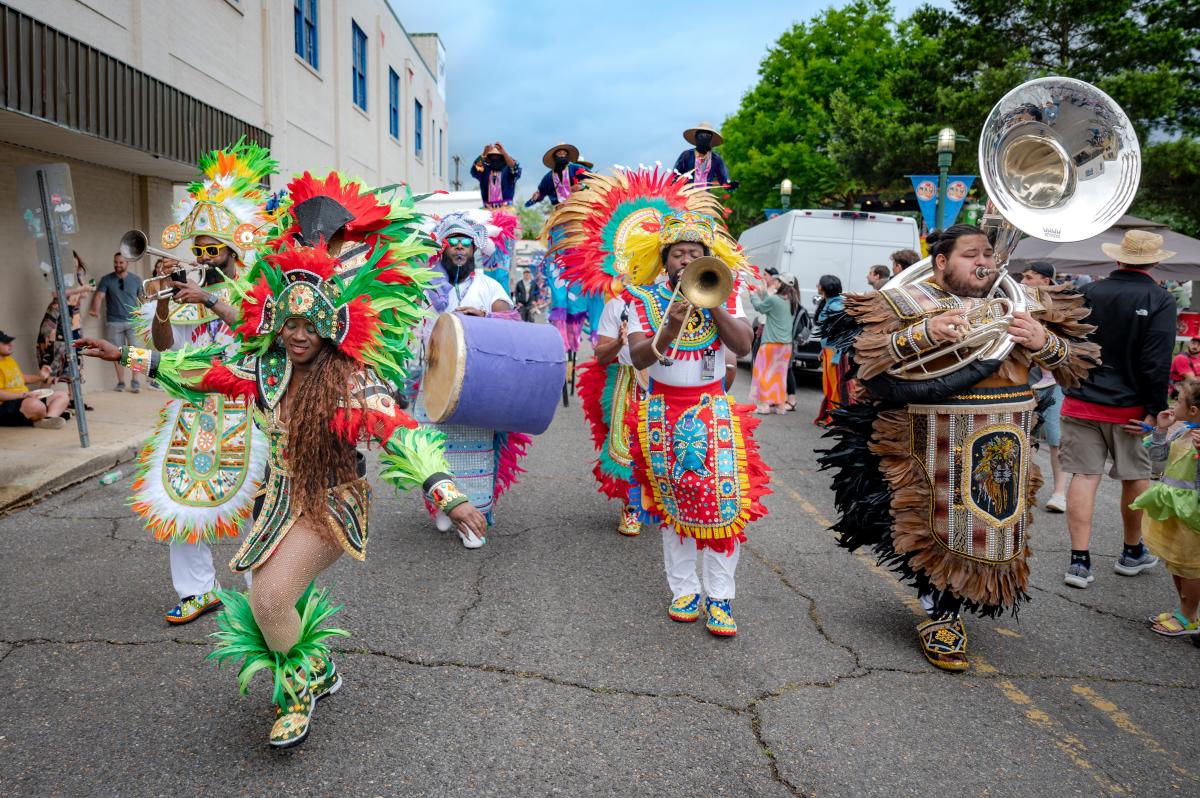During the last week of April, residents are decked out in hats, dancing shoes, and smiles along the streets of downtown Lafayette. Refrains of "Happy festival" are everywhere.
At the apex of spring, Lafayette's downtown turns festival mode for the annual Festival International de Louisiane, the largest outdoor, free Francophone event in the United States. Every year, artists worldwide perform on several downtown stages, known appropriately as scenes, allowing festival-goers the unique chance to hear world music up close and personal.
There's an international marketplace, unique arts and crafts, Lafayette's world-renowned cuisine, children's activities, a marathon, and so much more. Festival International brings in hundreds of thousands of tourists yearly, but it's also the city's treasured spring outing, an event locals look forward to all year.
"I love the festival because it brings the world to Lafayette," said Christy Leichty, a former Lafayette Parish drama teacher, writer, and performer. "The earth is a small place full of incredible culture and beautiful people, and we celebrate that in a big way in our happy little corner."
Festival International Origins

Festival International began with a depressed economy due to the sinking oil prices of the 1980s and one man's exposure to a new culture. Herman Mhire, then director of the University Art Museum at the University of Southwestern Louisiana (now the Hilliard Art Museum at the University of Louisiana at Lafayette), had been invited to a reception at the home of Maurice Dedieu, a French linguist. Before his time in Lafayette, Dedieu had lived in Senegal and discovered exquisite paintings on glass. On the walls of his house were these amazing paintings of Senegal, Mhire remembered.
Dedieu also related to Mhire the incredible music he had heard in Senegal, particularly Senegalese musicians Arfan and Kinda Diabate Kouyate. In early 1985, Mhire organized the exhibition "Senegal: Narrative Paintings" at the museum, and the Kouyates traveled to Lafayette to conduct a one-week residency. They performed traditional Senegalese griot music at the museum, in Lafayette Parish schools, at Southern University in Baton Rouge, and for Louisiana Public Broadcasting. Their final concert on the UL Lafayette campus was sold out. The music profoundly impacted Mhire, who grew up on a Cajun farm outside Lafayette. His exposure to world culture intensified when he traveled on business to Jordan, Amsterdam, and New York.
"I thought Lafayette needed an international festival," Mhire said. "My motivation as an educator was to open doors and windows to other experiences."
Mhire contacted a host of city officials who would be instrumental in bringing about such a festival: Philippe Gustin, director of the Council for the Development of French in Louisiana (CODOFIL); Jean Goyer, head of the Delegation du Quebec in Lafayette; Donnie Robin, administrative assistant to then Lafayette Parish President Walter Comeaux; Cathy Weber, director of the Downtown Development Authority; and Phil Lank, director of Community Development for the City of Lafayette. Michael Doucet of BeauSoleil, performing worldwide then, was the production and programming vice president.
"There were many skeptics and obstacles to overcome," Mhire said, "but the timing worked." Depressed oil prices had taken a hard toll on the Lafayette economy, with people joking that the last person leaving Lafayette should turn off the lights. But the economy was beginning to bounce back. Both state and local tourism officials saw a festival as a way to promote cultural tourism and stimulate the economy.
"They were looking for a way to climb out of the hole and feel good about themselves and the community," Mhire explained. "Ironically, the depression created an environment that allowed ideas to be considered. Cathy Weber once said that a consultant probably would have said it was impossible. It is lucky for us such a person didn't exist. Sometimes, it's better to follow your instincts and intuition. That's what we did, and it turned out pretty well."
The First Festival International

The founding board visited festivals in Quebec and met every Wednesday night at City Hall to hash out details. They received grants from tourism and Francophone countries and attracted hundreds of musicians and volunteers for the first Festival International de Louisiane on July 2-5, 1987, in downtown Lafayette.
The opening act on the main stage was a group of New Orleans Mardi Gras Indians who performed in elaborate costumes until a thunderstorm sent everyone running for shelter. After the storm subsided, Mhire feared the worst. "I'm thinking, this is doomed."
When he made it to the stage, he spotted smoke rising. The Master Drummers of Rwanda were warming the skins on their drums. "The syncopated, complex rhythms of those drums had the most complex patterns. We were sitting there, our jaws dropped. We were all mesmerized. Soon, hundreds of spectators returned. Something very powerful was connecting. Maybe that's the international power of music. Lafayette's response to performing arts and music is essential to the identity of this place. You didn't need to convince people. They responded on an emotional level."
Festival International Today

The Festival continues as an annual event, although the date has changed to late April to coincide with the New Orleans Jazz Festival. The connecting dates make it easier for foreign musicians to fly to the U.S.
Over the years, festival highlights include the unique culture of South Louisiana along with its French influences from the mother country of France, Canada, Africa, and the Caribbean. In addition, bands of all styles and languages have visited the festival stages. All promote an exchange of cultures unique to America.
